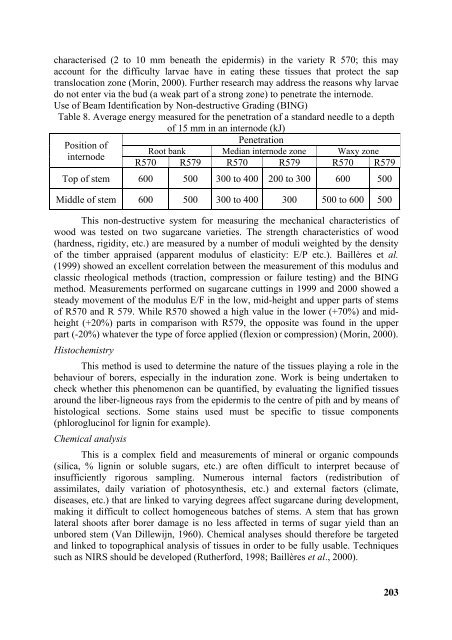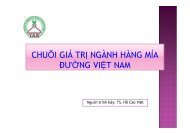TUYEÅN TAÄP
tuyeÃ¥n taäp - CHUYÃN TRANG GIá»I THIá»U CÃC GIá»NG MÃA Tá»T ...
tuyeÃ¥n taäp - CHUYÃN TRANG GIá»I THIá»U CÃC GIá»NG MÃA Tá»T ...
- No tags were found...
You also want an ePaper? Increase the reach of your titles
YUMPU automatically turns print PDFs into web optimized ePapers that Google loves.
characterised (2 to 10 mm beneath the epidermis) in the variety R 570; this may<br />
account for the difficulty larvae have in eating these tissues that protect the sap<br />
translocation zone (Morin, 2000). Further research may address the reasons why larvae<br />
do not enter via the bud (a weak part of a strong zone) to penetrate the internode.<br />
Use of Beam Identification by Non-destructive Grading (BING)<br />
Table 8. Average energy measured for the penetration of a standard needle to a depth<br />
of 15 mm in an internode (kJ)<br />
Penetration<br />
Position of<br />
Root bank Median internode zone Waxy zone<br />
internode<br />
R570 R579 R570 R579 R570 R579<br />
Top of stem 600 500 300 to 400 200 to 300 600 500<br />
Middle of stem 600 500 300 to 400 300 500 to 600 500<br />
This non-destructive system for measuring the mechanical characteristics of<br />
wood was tested on two sugarcane varieties. The strength characteristics of wood<br />
(hardness, rigidity, etc.) are measured by a number of moduli weighted by the density<br />
of the timber appraised (apparent modulus of elasticity: E/P etc.). Baillères et al.<br />
(1999) showed an excellent correlation between the measurement of this modulus and<br />
classic rheological methods (traction, compression or failure testing) and the BING<br />
method. Measurements performed on sugarcane cuttings in 1999 and 2000 showed a<br />
steady movement of the modulus E/F in the low, mid-height and upper parts of stems<br />
of R570 and R 579. While R570 showed a high value in the lower (+70%) and midheight<br />
(+20%) parts in comparison with R579, the opposite was found in the upper<br />
part (-20%) whatever the type of force applied (flexion or compression) (Morin, 2000).<br />
Histochemistry<br />
This method is used to determine the nature of the tissues playing a role in the<br />
behaviour of borers, especially in the induration zone. Work is being undertaken to<br />
check whether this phenomenon can be quantified, by evaluating the lignified tissues<br />
around the liber-ligneous rays from the epidermis to the centre of pith and by means of<br />
histological sections. Some stains used must be specific to tissue components<br />
(phloroglucinol for lignin for example).<br />
Chemical analysis<br />
This is a complex field and measurements of mineral or organic compounds<br />
(silica, % lignin or soluble sugars, etc.) are often difficult to interpret because of<br />
insufficiently rigorous sampling. Numerous internal factors (redistribution of<br />
assimilates, daily variation of photosynthesis, etc.) and external factors (climate,<br />
diseases, etc.) that are linked to varying degrees affect sugarcane during development,<br />
making it difficult to collect homogeneous batches of stems. A stem that has grown<br />
lateral shoots after borer damage is no less affected in terms of sugar yield than an<br />
unbored stem (Van Dillewijn, 1960). Chemical analyses should therefore be targeted<br />
and linked to topographical analysis of tissues in order to be fully usable. Techniques<br />
such as NIRS should be developed (Rutherford, 1998; Baillères et al., 2000).<br />
203






